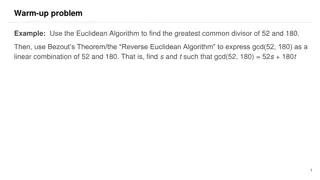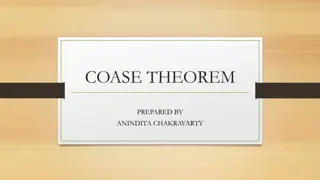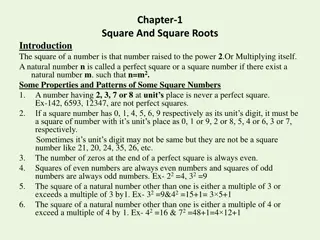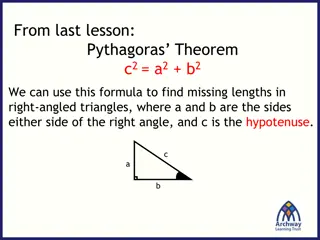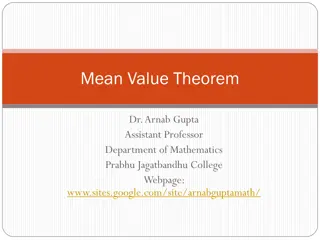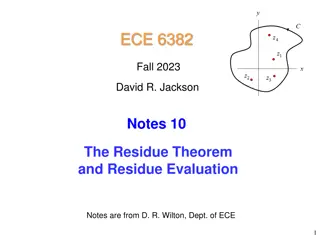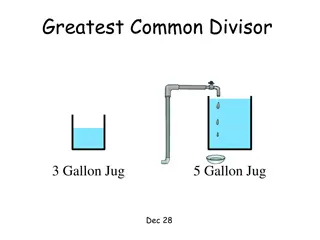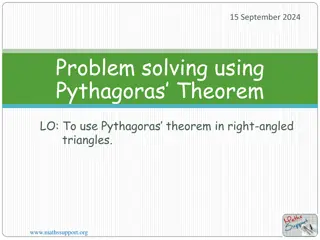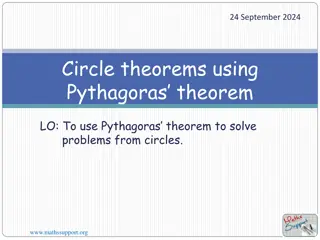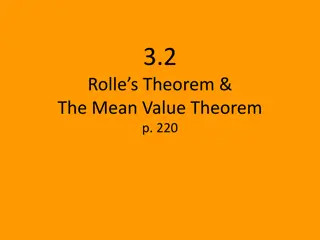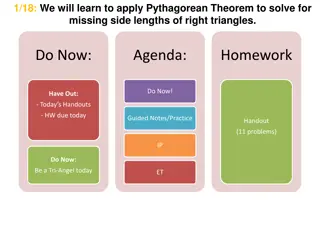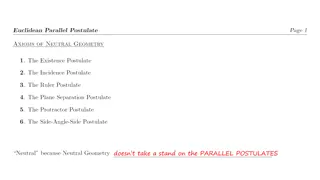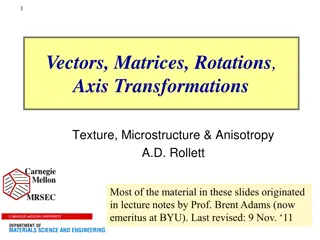Understanding Euclidean Geometry and the Pythagorean Theorem
Explore the foundations of Euclidean Geometry, delve into the Pythagorean Theorem, discover the postulates of Euclid, and learn about distance functions, Euclidean distance, taxi-cab metric, circles, and isometries and congruence. Unravel the rich history, key principles, and practical applications of these fundamental concepts in mathematics.
Download Presentation

Please find below an Image/Link to download the presentation.
The content on the website is provided AS IS for your information and personal use only. It may not be sold, licensed, or shared on other websites without obtaining consent from the author. Download presentation by click this link. If you encounter any issues during the download, it is possible that the publisher has removed the file from their server.
E N D
Presentation Transcript
Euclidean Geometry http://www.youtube.com/watch?v=_KUGLOiZyK8
Pythagorean Theorem Suppose a right triangle ABChas a right angle at C, hypotenuse c, and sides a and b. Then
Proof of Pythagorean Theorem What assumptions are made? Other proof: http://www.youtube.com/watch?v=CAkMUdeB06o Pythagorean Rap Video
Euclids Elements Dates back to 300 BC Euclid s Elements as translated by Billingsley appeared in 1570 Ranks second only to the Bible as the most published book in history
Euclids First 4 Postulates 1. We can draw a unique line segment between any two points. 2. Any line segment can be continued indefinitely. 3. A circle of any radius and any center can be drawn. 4. Any two right angles are congruent.
Euclids 5th Postulate (Parallel Postulate) 5. Given a line l and a point P not on l, there exists a unique line l through P which does not intersect l.
Distance Let d(P,Q) be a function which assigns a positive real number to any pair of points in the plane. Then d is a distance function (or metric) if it satisfies the following three properties for any three points in the plane: 1. d(P,Q) = d(Q,P) 2. d(P,Q) 0 with equality if and only if P = Q 3. d(P,R) d(P,Q) + d(Q,R) (triangle inequality) (often write |PQ| for distance)
Euclidean Distance Let P = (a,b) and Q = (c,d). Then the Euclidean distance between P and Q, is |PQ|= (a-c)2 + (b-d)2
Taxi-cab Metric A different distance, called the taxi-cab metric, is given by |PQ| = |a-c| + |b-d|
Circles The circle CP(r) centered at P with radius r is the set CP(r)={Q : |PQ| = r}
Isometries and Congruence An isometry is a map that preserves distances. Thus f is an isometry if and only if |f(P)f(Q)| = |PQ| Two sets of points (which define a triangle, angle, or some other figure) are congruent if there exists an isometry which maps one set to the other
More Axioms to Guarantee Existence of Isometries 6. Given any points P and Q, there exists an isometry f so that f(P) = Q (translations) 7. Given a point P and any two points Q and R which are equidistant from P, there exists an isometry f such that f(P) = P and f(Q) = R (rotations) 8. Given any line l, there exists an isometry f such that f(P)=P if P is on l and f(P) P if P is not on l (reflections)
Congruent Triangles: SSS Theorem: If the corresponding sides of two triangles ABC and A B C have equal lengths, then the two triangles are congruent.
Categories of Isometries An isometry is a direct (proper) isometry if it preserves the orientation of every triangle. Otherwise the isometry is indirect (improper). Important: It suffices to check what the isometry does for just one triangle. If an isometry f is such that there is a point P with f(P) = P, then P is called a fixed point of the isometry.
Transformations 1. An isometry f is a translation if it is direct and is either the identity or has no fixed points. 2. An isometry f is a rotation if it is a direct isometry and is either the identity or there exists exactly one fixed point P (the center of rotation). 3. An isometry f is a reflection through the line l if f(P) = P for every point P on l and f(P) P for every point P not on l.
Sample Geometry Proof Prove that if the isometry f is a reflection, then f is not a direct isometry.
What happens if You do a reflection followed by another reflection? You do a reflection followed by the same reflection?
Parallel Lines Euclid stated his fifth postulate in this form: Suppose a line meets two other lines so that the sum of the angles on one side is less that two right angles. Then the other two lines meet at a point on that side.
Angles and Parallel Lines Which angles are equal?
Sum of Angles in Triangle The interior angles in a triangle add up to 180
More generalizing What about polygons with n sides? What about regular polygons (where all sides have the same lengths and all angles are equal)?
Another Geometry Proof Theorem (Pons Asinorum):The base angles of an isosceles triangle are equal.
Symmetries of the Square A symmetry of a figure is an isometry of the plane that leaves the figure fixed. What are the symmetries of the square?
The Group of Symmetries of the Square The set {a,b,c,d,e,f,g,h} together with the operation of composition (combining elements) forms a group. This is a very important mathematical structure that possesses the following: 1. Closed under the operation 2. The operation is associative (brackets don t matter) 3. There is an identity element 4. Every element has an inverse
Frieze Groups A frieze group is the symmetry group of a repeated pattern on a strip which is invariant under a translation along the strip Here are four possibilities. Are there any more?
Wallpaper Groups Symmetry groups in the plane Show up in decorative art from cultures around the world Involve rotations, translations, reflections and glide reflections How many are there?
Similar Triangles AB/DE = AC/DF = BC/EF
Pentagon Exercise Which triangles are congruent? Isosceles? Similar?
The Golden Ratio The golden ratio is defined to be the number defined by = (1 + 5)/2 1.618
What is the ratio of your height to the length from the floor to your belly button?



